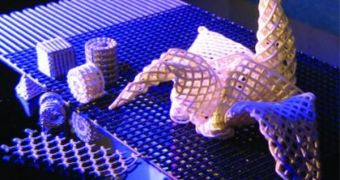Given the high level of miniaturization current technologies operate at, it stands to reason that a wide variety of very small systems need to be devised. The future of most industries lies in producing tiny versions of existing equipments, which could be introduced in mechanical, biological and chemical system at the micro- and nanoscale. For example, being able to produce incredibly small structures of various intricate shapes could innovate the fields dealing with the production of biocompatible devices, microscaffolding structures and other microsystems.
Recently, investigators from the University of Illinois in Urbana-Champaign (UIUC), led by Professor Jennifer Lewis, managed to develop a new method for producing intricate, three-dimensional structures at very small scales. Their work was based on previous researches that looked at methods of using printed sheet of titanium hydride ink for producing such objects. Their advancements are published in the April 14 online issue of the respected scientific journal Advanced Materials.
“Most of our inks are based on aqueous formulations, so they dry quickly. They become very stiff and can crack when folded,” explains Lewis, who is also the Director of the UIUC Frederick Seitz Materials Research Laboratory. She is also appointed as the Thurnauer Professor of Materials Science and Engineering at the university. The team's approach basically relies on printing a flat sheet of titanium, and then twisting the material in a spiral, or even fold it in various structures – an origami. However, doing this is a little more difficult in practice than it is in theory.
The issue previous studies stumbled upon was that folding the sheets resulted in many of the layers in the new structure collapsing under their own weight. This happened during the annealing process, which is meant to remove liquid molecules from the final constructs, leaving them completely solid. The UIUC team got past this obstacle by using a mixture of fast-drying and slow-drying solvents in the titanium ink. This allowed their sheets to be malleable, while at the same time retaining their strength. The group managed to create a crane bird using this technique. The model features 15 folds and all of them endured the annealing process without breaking.
“By combining these methods, you can rapidly assemble very complex structures that simply cannot be made by conventional fabrication methods. We've really just begun to unleash the power of this approach,” Lewis explains. Possible applications for the new production method include the creation of very lightweight structures, biomedical devices, and more advanced sensors, the team believes.

 14 DAY TRIAL //
14 DAY TRIAL //